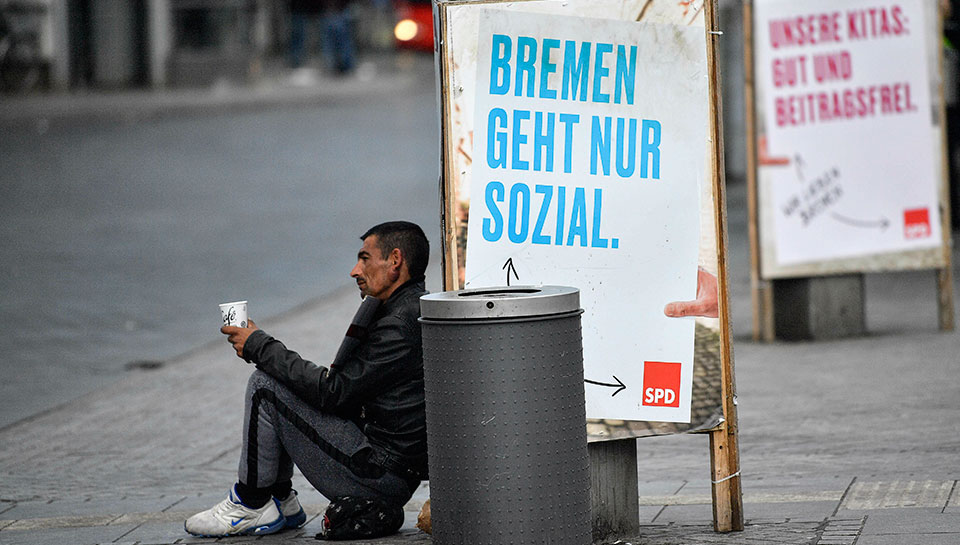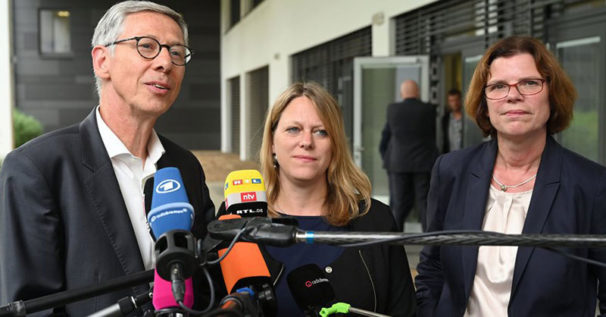
BERLIN—In an election last week in Bremen, Germany’s poorest state, the voters put into power the first red-red-green coalition ever elected in a state that was part of the old West German Federal Republic of Germany.
The victory for the left there is satisfying not just because it contrasts with recent gains in some parts of Germany for the extreme right but because of the way it happened. The Social Democrats (SPD), defying the example of their party on a national level, decided to hook up with Die Linke (the Left Party), rather than the Christian Democrats with whom the federal SPD is allied in what is called a “Grand Coalition.”
The Green Party in Bremen is also notoriously to the left of the Green Party nationally, which has lately been allying itself with a number of the nation’s largest corporations. In Bremen, the Green Party has often sided with labor unions and with Die Linke on a range of issues, including the fights for affordable housing and improved education.
Even Die Linke in Bremen has staked out positions to the left of those taken by the party in some other states. In Bremen, Die Linke has been an outspoken advocate of and leader in more militant actions, stressing demonstrations and mass protests in addition to electoral work.

Unity of the left-of-center and left forces there paid off on election night because it prevented the conservative Christian Democrats, who came in first with 27% of the vote, from using the advantage of the first-place vote-getter to form a government. The “Christians” were prevented from doing that when the Social Democrats joined with Die Linke and the Greens to form a majority government in Bremen.
Part of the motivation for the Social Democrats to join with Die Linke was, of course, their desire to save their own skins and remain in the government which they had led in Bremen up until the election. The other part was undoubtedly how disastrous the Grand Coalition with the “Christians” has been for their party.
Nationally, the Social Democrats are polling at 12.7%, behind the Christian Democrat/Christian Social Union tally of 25.7%, the Green Party total of 24%, and the AfD (neo-Nazi) tally of 13%. Those Social Democratic numbers have been dropping rapidly ever since the federal SDP threw most of its principles out the window and jumped in bed with the Christian Democrats. For many years, the SPD had been the leading party in Germany.
In the national polls, Die Linke is polling fifth with 8.5% of the vote and the Free Democrats (a pro-small and mid-sized business party) is polling sixth with 7.7% of the vote.
The big news in the national polls is the rise in popularity of the Green Party, especially among young people. Fueled by the growing national and worldwide concern for the environment, the party is also benefiting from the fact that many voters are looking for an alternative to the system, and they see the Greens as just such an alternative. The Greens, however, are no longer the left-wing radical party they were when they started out more than 30 years ago. While they sometimes align themselves with the left, as they did recently in Bremen, there are many places where they line up with the Christian Democrats and the corporate interests that back that party.
The AfD, while it has 13% nationally, is far stronger in some areas, like Saxony in the east, where it gets a quarter of the vote. So far, it has been kept out of ruling coalitions in the states but its support has been steadily growing, particularly in areas where working-class people have seen little or no economic gain in recent years. Like the Trump campaign did in the U.S., the AfD appeals to whipped up anti-immigrant propaganda.
Die Linke, despite lower votes nationally, has scored major success now in four German states, three others in addition to Bremen.
In Thuringia, formerly part of the socialist German Democratic Republic (East Germany), all the right-wing parties have been kept out of the government with Die Linke. It is the leading party there in a three-party governing coalition of itself, the Social Democrats, and the Greens.
In Brandenburg, too, the right has been held back from the government with a red-red governing coalition of the Social Democrats, the leader, and Die Linke.
And in Berlin, too, there is a governing red-red-green coalition consisting of the leading Social Democrats, Die Linke, and the Greens.
The importance of these successes should not be underestimated, as the Berlin government is now in the early stages of taking over a voracious real estate magnate, Deutsche Wohnen. There is a full-fledged campaign underway in the city for a rent freeze.
On the downside in the most recent elections: In Bremen, although they were able to save their political skin and remain in the government, the Social Democrats were outnumbered by the “Christians” for the first time since 1949. They were able to save themselves only by joining with Die Linke, which itself made gains in the recent elections in Bremen.
The new coalition government in Bremen will be a test of whether the left wing of three different political parties—the Social Democrats, Die Linke, and the Greens—working together can make some improvements in the lives of the people, improvements in salaries, housing, and education. Recent upswings for each of those three parties in Bremen should continue if they succeed.
The other big question will be how the right wing reacts. No one puts it past even the so-called “respectable” conservatives to join with the neo-Nazis, if it’s the only way they can maintain a system of control by the one percent.










